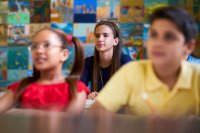Student-Centered Planning
Planning instruction around students’ readiness, interests, and learning preferences empowers them to drive their own learning.
Your content has been saved!
Go to My Saved Content.Even the best lesson plans do not survive unchanged on first contact with students. Those who struggle will need modifications to help them learn, and advanced learners will need adjustments so that they’re stretched for their personal growth and don’t just regurgitate what they already know. Successful instruction plans for these differentiation needs—and highly effective instruction also involves students’ readiness, interests, and learning preferences.
Learners’ involvement begins with how inviting the lesson appears to them. Learners evaluate a lesson based on their readiness, their sense that it’s something they can do. Does the learning experience provide sufficient supports to help them develop the skills to succeed?
Learners determine if they’re interested based on real-world connections that they find meaningful. Is purposeful context shown between abstract concepts and their life experiences?
Students apply their learning preferences by looking for options where they can choose an approach to processing and demonstrating understanding. Does the learning experience provide a variety of different reflection opportunities and ways to craft products?
Let’s take a deeper dive into readiness, interests, and learning preferences.
Readiness: Students’ Understanding of Their Own Needs
Planning for readiness begins with making sure students understand their strengths and their opportunities for improvement. Formative assessment is an important tool for identifying the status of each skill you want students to develop. Some areas might be strong and others weak. It’s important for students to know their strengths so that they can replicate practice.
Differentiation for readiness is about providing supports so that a learner can improve all skills. Involve students in reflection about assessments so that they become knowledgeable about the whys and whats of their skills.
Like an athlete working with a coach, a self-aware student can be a partner with teachers to make adaptations or self-identify areas of needs.
Interests: Encouraging Student Involvement in Learning
Understanding students’ interests begins with having them share how they spend their free time. Including their interests gives valuable context for them to connect abstract concepts and skills to the world they navigate both in and out of school.
Designing lessons around the interests of all learners in your class may sound daunting. An easy first step is to focus on topics and products. When the required skills allow it, let students choose their topic—what to research, what type of experiment to do, what line of inquiry to follow, or what to read.
Products are best when the criteria focus on the skills to be demonstrated, not the logistics of the mode of display. Ask students to propose the display tool they want to use, and give them a thumbs up or down as to appropriateness. Choosing the topic and mode of displaying learning places them in the driver’s seat for their learning experiences.
Learning Preferences: Processing Is in the Mind of the Thinker
Taking advantage of learning preferences begins with having students reflect on and express the ways they prefer to process their thinking. Learning styles and inventories are useful for establishing a common language for how each person approaches thinking and making sense.
Such preferences should not be used to define the instructional parameters for planning lessons. No one is just a visual, kinesthetic, or auditory learner. No one is solely creative or practical. Avoid the trap of isolating students into one learning preference.
Depending on your established common language, engage students in a reflective conversation about the range of ways that they prefer to make sense of different types of tasks.
Consider two starter steps to effectively address learning preferences:
3D instruction: Include three different types of learning approaches in a lesson or activity that everyone will participate in. When students experience content from different approaches, that offers a deeper perspective. Strategies like think dots, learning menus, and learning centers or stations are opportunities for students to be exposed to tasks from different approaches.
Even a lecture can incorporate three different learning approaches, such as a visual or video, reflective writing at the midpoint, and Cornell note-taking, in which students take notes on the right-hand two-thirds of their notebook page, and then on their own use the left-hand third to write questions about the notes to clarify their thinking.
Learning preferences cards: Use learning preferences cards as a reference for how students prefer to think and tackle learning tasks. The cards can be sorted to form learning teams where each participant has a strength to contribute. They can also be used to call on students to answer a question whose framing is based on the information about students’ approaches to thinking.
Provide each student with an index card to rate themselves on the identified learning approaches and academic skills, based on a description of the thinking that is student friendly and developmentally appropriate. Collect the cards and annotate them with personalized information based on ongoing observations.
Student Empowerment
Telling is not teaching. Just because students have been told content does not mean that learning has taken place. Such one-sided instruction at best allows the instructor to check off the boxes for content coverage. It also releases students of any accountability.
Placing students’ readiness, interests, and learning preferences at the forefront empowers students to experience lessons on their own terms.
